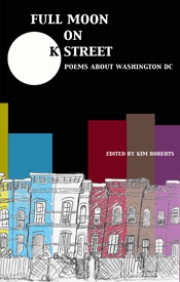Wynn Yarbrough

by Kim Roberts
Plan B Press with Beltway Poetry Quarterly
2009
$20
Poems about Washington, D.C.
Edited by Kim Roberts
Plan B Press in conjunction with Beltway Poetry Quarterly
One would not have to be out of touch to have a disdain for Washington, D.C. these days: whatever your political stripe, your issue du jour, your favorite target of disdain. But the city and the political capital of the country don’t often meet–they aren’t in the same place, particularly for the people who live here and not for the connections, whether it be for the job, the firm, or the corporation back home. This is home for many writers and has been for centuries.
“We live in a Federal District which operates like a colony,” says Kim Roberts in her introduction. And many of the writers in this anthology explore psychological, aesthetic, and political complications of this peculiar geography. There are poems by A.B Spellman, Elizabeth Alexander, and Liam Rector, as well as lesser-known poets. But the compulsion for me, as a reader, was easily towards poems that chronicled the city through its local byways, poems like “The Jello Man on the Feast of the Circumcision,” “There’s Been a Killing in the Neighborhood,” “Snookie Johnson Goes Down to the Recruiter’s Office Near Benning Road and Starts Some Shit,” and “Tambourine Tommy.” This last poem, by Thomas Sayers Ellis, reads almost like a picture of initiation and belonging:
More man
Than myth, more myth
Than freak, he would come out
Between bands
In a harness of bells
And high-waters
Held together and up
By a belt of rope.
Seemingly a curiousity for Ellis, “Tommy” becomes emblematic of life for DC natives east of the Anacostia River:
…the way
He beat himself (head, shoulders, knees
and toes), proved he
Was one of us,
A soul searcher
Born and raised
In the District,
Proved he
Could reach in,
Blend. . . .
One of the strengths of this collection is that local geography and life is always touched by national life and events, whether that be Bush’s second inauguration in “Second Inauguration” or the legacy of slavery and Lincoln’s maid in “Elizabeth Keckley: 30 Years a Slave and 4 Years in the White House.” Since so much history has taken place in D.C. and continues into the present moment, this collection engenders much of its richness from the intersections that are available to a poet writing for and in this city, even if it is because of nationwide outlets like the Kennedy Center, as in “billy eckstine comes to washington, d.c.” where national fame intersects with local preoccupation.
back in the day he was there
on u street with stokely when
word came that the king was dead
and the country would burn
break crack and wail
sometimes i look at him
see my grandfather
on the porch preaching
about unions
or willie “the lion” smith
at the piano
reminding young upstarts
that his fingers can
still dance like
chorus girls
rehearsing for
a show
This isn’t to say that there aren’t poems that read like dictates on politics: one may even expect that from an anthology of poets from D.C. But, for the most part, the poems encapsulate the 20th century in remarkable ways. Roberts organized the anthology based on the birth date of the poet. In this case, the first poem is “The Washingtonian” by May Miller, born in 1899, and the last poem is “There Were Homes” by Abdul Ali, born in 1984. In many ways, you can read the changing aesthetics of the various decades as well as the changing cultural make up of the city due to Roberts’ ear for different voices.
For what it is worth, I found copious amounts of humor in this collection as well as a concern for different ways of seeing. For example, Richard Peabody’s “I’m in Love with the Morton Salt Girl” ends with “When she is done I will lick her salty lips with my tongue/ and walk her down the stairs into the rain, wishing that I/ could grow gills and bathe in her vast salt seas” or the almost Fitzgerald moment of Daniel Gutstein’s “Valise variations” with:
hashes a scoop of cranberry
a scoop of taters
a scoop of stuffing
outside public kitchen
a mimic thrasher
catbird
building next and nestling
atop crown of flickery signage “Eats
in the measure of its eye
its rustic housecoat
missing
the weather of your wit
kind instrument of your variance
As the collection progressed, I tended to enjoy the later work more (which is not much of a surprise to me as my taste in aesthetics runs towards play and discovery). I would be remiss if I didn’t mention Toni Asante Lightfoot’s “Mothership Future Dream Palabramorphetic” where the language play and the concert attended by the narrator and sister are a gumbo of narrative, language and image:
Blue haze floats and grows over the roof of the Capital
Center. This place is new, shiny, unprepared.
There are a dozen Black folk on stage dressed
psychoanfronegrofuturemetastylistic.
Flue must be clogged, smoke unable to rise out
tumbles down. My sister is bellbottoms, braids,
and anticipation. Me? 10 year old cock blocking
machine revved with starsky and hutch lunchbox.
And while Lightfoot’s George Clinton vision delightfully takes us on a journey that may remind readers of a P Funk concert, her poem serves as reminder of what is best about this collection: it is a gumbo. Organizing an anthology around a city—Roberts reminds us that it is also a celebration of ten years of the Beltway Quarterly, an online magazine—allows for a variation of voices that are situated in the same place. In that vein, I found the collection captivating because of the different stories from writers of the same age writing about the same place.
In 2010, Vincent Gray, the new mayor of Washington, D.C., may have won the election due to his “One City” slogan. But, if this collection demonstrates anything, it shows the reader that the richness of the city exists precisely because it houses so many different voices trying to work out a life in a city that is at times bloody, political, racist, and, often, surreal.

